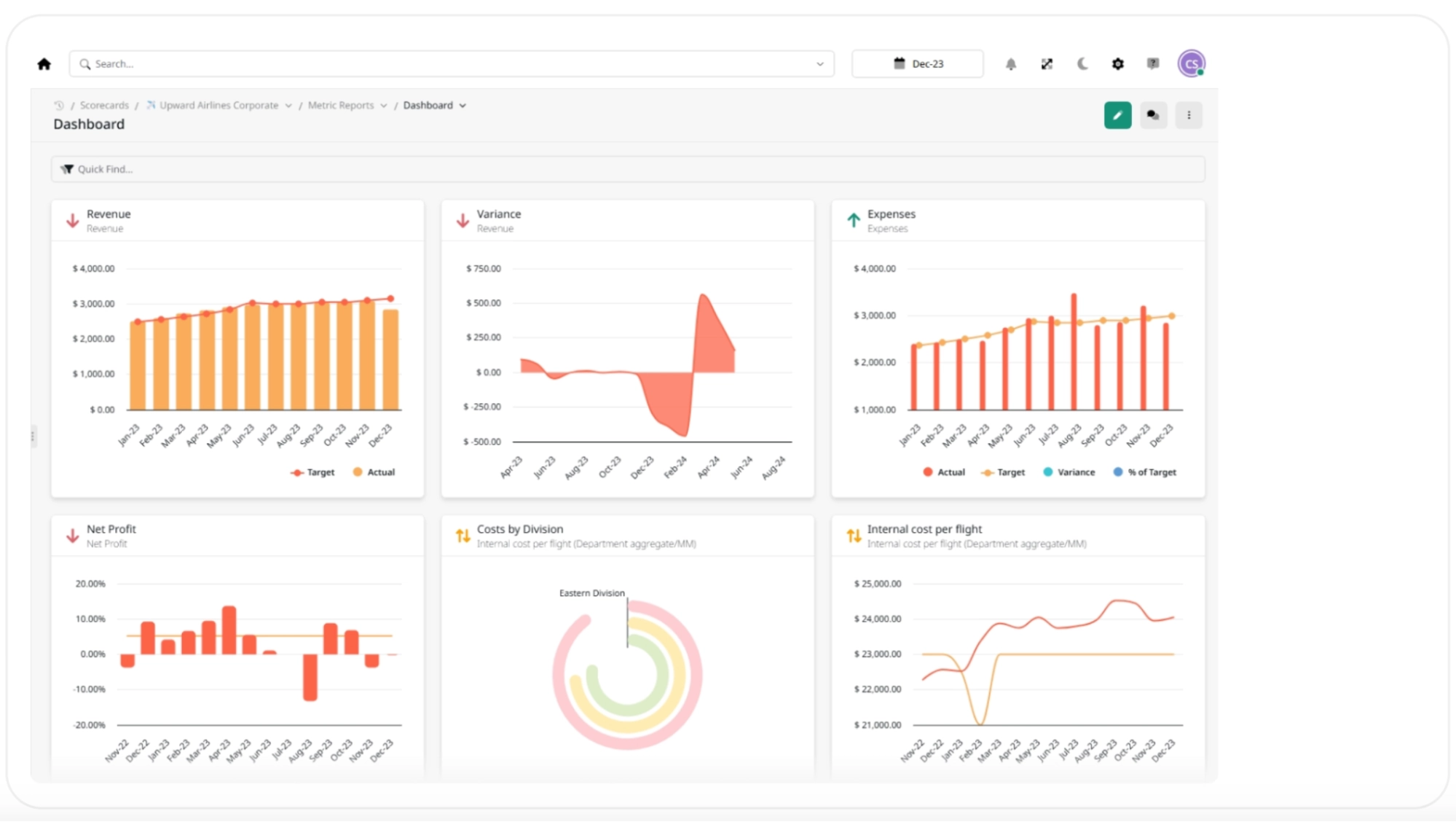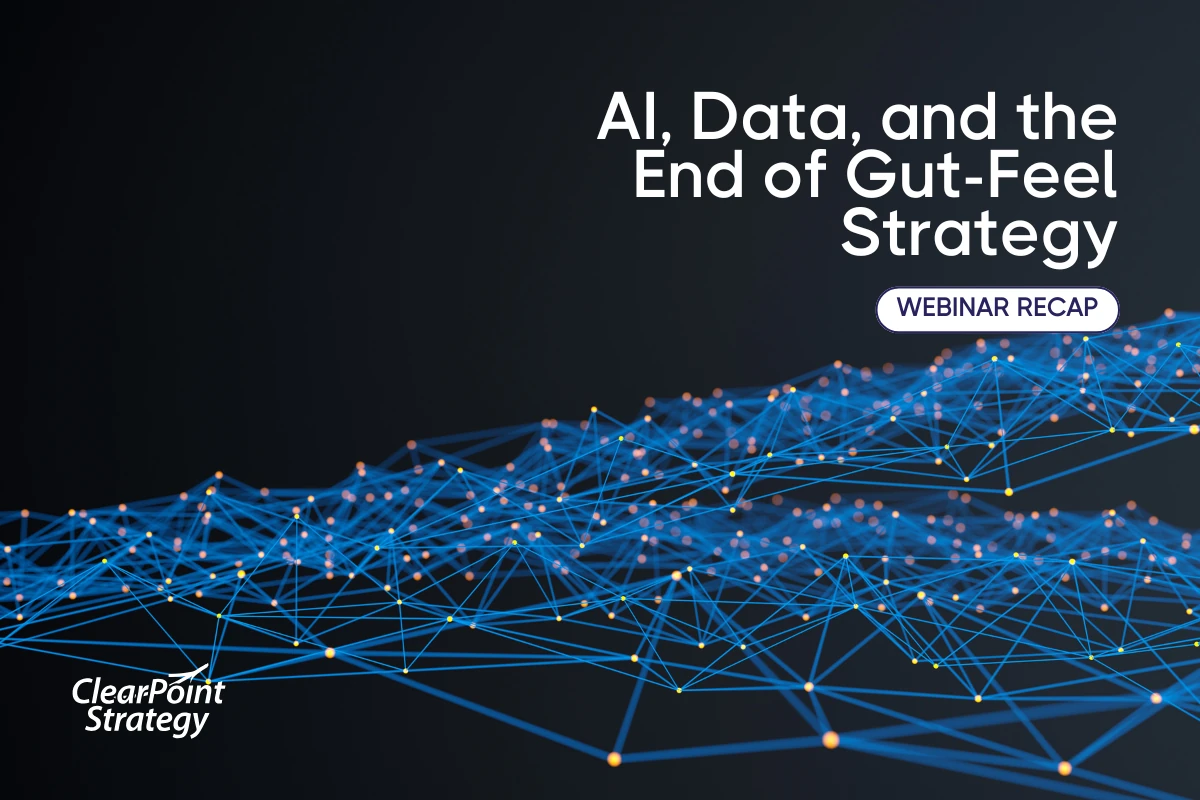Here’s how AI and data are transforming strategy management for smarter decision-making.
Relying solely on gut instincts to guide strategy is becoming a thing of the past.
In a recent thought-provoking webinar, Ted Jackson, co-founder of ClearPoint Strategy, teamed up with Mathias Mangels, President and Chief Revenue Officer of ReTHINKING WORKS, to discuss how AI and data are rewriting the rules of strategy management.
The bottom line:
Strategy management is no longer an art guided by gut feel but a disciplined, data-fueled process that enables faster, smarter decisions and drives meaningful results.
Watch the full webinar recording here.
Rethinking Strategy Execution with AI
Companies are pressured to innovate or fall behind.
ReTHINKING WORKS is helping organizations do the former by integrating AI and machine learning into strategy execution. Its platform combines a powerful AI decision engine with agile methodologies to provide real-time data analysis, predictive insights, and actionable recommendations.
This fusion of AI intelligence and agile execution enables leaders to move beyond static planning. Instead, they can identify risks, optimize resources, and align teams dynamically as conditions evolve.
The integration of AI’s real-time insights and predictive power is transforming multiple facets of strategy, from defining KPIs and setting targets to enhancing dashboards, enabling alignment, forecasting vision achievement, and advancing scenario planning.
The Evolution of KPIs and Data-Driven Insights
One of the most important data types in any organization is the KPI.
Five years ago, says Mathias, organizations developed KPI libraries and applied them as they saw fit. “We tried to collect some libraries from the market, from the sector, from trade associations. And we also created our own KPIs by looking into our processes, understanding the challenges, and determining the key success factors around these processes.”
Today, KPI development has changed dramatically.
Where KPI selection used to rely on static libraries and guesswork, AI now unlocks unprecedented access to global, sector-specific data and predictive insights. Additionally, organizations can identify not only lagging KPIs but also the critical leading indicators that truly forecast success.
“The world has changed a lot. We have to understand what [KPIs] are really the best fit for a certain challenge an organization has. Today, we have this opportunity to very quickly find out different aspects of KPIs and their applications by sector, tapping into the ones that best fit our objective, best fit what we want to measure.”
AI is enabling and supporting organizations’ attempts to identify the right capabilities and the right key success factors for their individual journey.
ClearPoint itself incorporates AI to suggest relevant KPIs tailored to specific objectives and industries. This shift has turned KPI selection from a manual, time-consuming task into a strategic brainstorming exercise, opening doors for more precise and actionable measurement.

Target-Setting Gets Smarter with AI
Traditional target-setting leaned heavily on historical performance data and benchmarking against industry peers.
Now, AI transforms target-setting by combining historical data with real-time signals and sector trends to predict the most realistic and achievable future goals.
“You can today, very quickly, link your historical database with the databases of your sector. By foresighting scenarios, you can choose the scenario that you think will be the most likely one.”
Rather than settling for just inspiring targets, organizations can now design strategies grounded in data-driven foresight that align with evolving market conditions, economic factors, and regional developments — making ambitious goals both motivating and practically attainable.
In sectors like healthcare, AI-driven scenario planning helps organizations craft ambitious yet realistic long-term targets by factoring in evolving treatments and wellbeing trends.
This makes targets not just inspirational but aligned with changing market realities.
From Static Dashboards to Dynamic Control Towers
Dashboards have historically been staples for decision-makers, displaying historical and forecast data. However, the future lies in “control towers” — advanced AI-powered platforms that act as command centers for ongoing strategic navigation.
These control towers aggregate live data, alert leaders to risks and opportunities, assess initiative progress, and even recommend actions to course-correct or accelerate. For example, an AI agent can suggest staffing competencies needed for success or flag a project lagging due to resource constraints.
“[AI] tells you not only the initiatives, but also how initiatives will have to be staffed and with what kind of competency for you to be successful.”
For example, “‘The competency has to be Fred and Alice, and don't forget Jane, because they really understand this. And also include that subject matter expert, John; he is the guy that will help make that initiative happen.’
“I see our journey going that direction, and it's not fictitious, future thinking. It's happening today already.”
This dependency on AI assistants elevates decision-making from reactive to proactive.
AI for Strategic Alignment and Collaboration
Achieving alignment across departments and initiatives is crucial. AI tools now help validate the coherence of strategy maps and scorecards both vertically (top-down) and horizontally (cross-departmental).
Case studies show AI uncovering collaboration gaps and conflicting projects — a scenario that helps prevent duplicated efforts and maximizes impact.
Ted points out that ClearPoint has always had what they call an alignment matrix, where you can see how all your objectives, measures, or initiatives play against each other. You also have the ability to drill down from a goal to see everything that links and aligns to it.
“We’ve had many of our clients say they've saved several million dollars finding two different projects that were going against each other.”
To make it even easier to flag conflicts, ClearPoint will soon launch an AI alignment tool.
It will allow users to look across the organization and see if targets are aligned and if departmental goals will help you reach your organizational goals. Finding and addressing these conflicts in your strategy could save organizations time and millions in operational efficiencies.
Predicting Vision Achievement with AI
While visions are inherently aspirational and rarely go exactly as planned, AI contributes to developing realistic roadmaps and continuously adjusting them. Organizations benefit from rapid course corrections as internal and external factors evolve.
For example, after setting aggressive growth targets, ClearPoint used AI to generate a strategic plan based on past results, which closely matched its human-led planning, leading to more informed target adjustments.
Scenario Planning Enhanced by AI
Scenario planning isn’t about predicting the future with certainty but preparing for multiple possible outcomes. AI augments this process by evaluating the probability and impact of various scenarios in real time, helping leadership select the most likely paths and adapt swiftly.
It monitors risks, provides early warnings, and suggests mitigation or opportunity leverage actions, making scenario plans living documents that evolve alongside business conditions.
Final words of advice for getting started with strategy management…
For those new to strategy management, the advice is to start simple but rich: Focus on building a solid decision-making infrastructure without overcomplicating from the outset.
- Use tools like ClearPoint to monitor strategy actively.
- Learn from the outcomes.
- Progressively increase sophistication in both strategic design and data utilization.
- Secure full leadership support.
AI is no longer supplementary in strategy; it is foundational — take advantage of it!

.svg)



![What's The Exact Right Number Of KPIs To Track? [DATA]](https://cdn.prod.website-files.com/637e14518f6e3b2a5c392294/6933449aba311e40db9ed2fa_what-is-the-exact-right-number-of-kpis-to-track-blog-header.webp)
